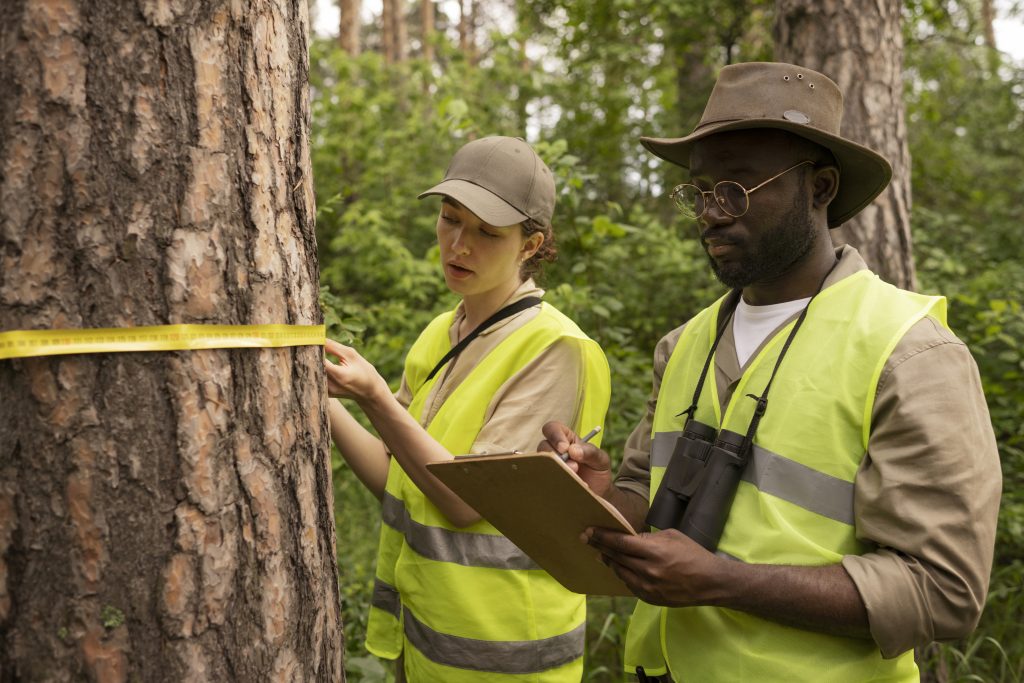COMMON TREE DISEASES IN UTAH AND HOW TO TREAT THEM
COMMON TREE DISEASES IN UTAH AND HOW TO TREAT THEM
Addressing tree diseases is crucial for the health and vitality of both individual trees and the broader ecosystem. Trees provide numerous benefits to the environment, communities, and human well-being, making their protection and preservation essential. Here’s why addressing tree diseases is important:

- Tree Health and Longevity: Trees are living organisms susceptible to diseases caused by fungi, bacteria, viruses, and other pathogens. Left untreated, diseases can weaken trees, leading to reduced growth, decline, and even death. Addressing diseases ensures that trees remain healthy and live longer.
- Ecosystem Resilience: Trees are integral parts of ecosystems, contributing to biodiversity, habitat provision, and ecosystem services. Diseased trees can disrupt ecosystem dynamics, affecting wildlife, soil health, and nutrient cycling. By addressing diseases, the overall resilience and functioning of ecosystems are maintained.
- Aesthetic and Environmental Value: Trees enhance the aesthetic appeal of landscapes, contribute to urban greenery, and improve air quality. Diseased trees can detract from the beauty of natural and urban environments, impacting property values and the visual appeal of communities.
- Air and Water Quality: Healthy trees play a significant role in air quality improvement by absorbing pollutants and releasing oxygen. Additionally, trees help filter rainwater and improve water quality by reducing runoff and erosion. Addressing diseases ensures that trees continue to provide these vital ecosystem services.
- Carbon Sequestration and Climate Regulation: Trees absorb carbon dioxide (CO2) during photosynthesis, mitigating climate change by sequestering carbon. Diseased trees may not function optimally in this capacity, affecting efforts to combat climate change.
- Biodiversity Preservation: Trees provide habitats for various species, contributing to local biodiversity. When diseases affect tree populations, it can disrupt the habitats and food sources of associated flora and fauna.
- Preventing Epidemics: Some tree diseases have the potential to become epidemics, affecting large areas and causing widespread ecological and economic damage. Timely disease management prevents the rapid spread of pathogens.
- Public Safety: Diseased trees are prone to dropping branches or falling over, posing risks to people, property, and infrastructure. Addressing diseases reduces the likelihood of accidents and injuries.
- Economic Impact: Tree-related industries, such as forestry, timber, and horticulture, are vital to economies. Disease outbreaks can negatively impact these industries and lead to financial losses.
- Community Well-Being: Trees contribute to the overall well-being of communities by providing shade, recreational spaces, and a sense of natural beauty. Addressing diseases preserves these benefits for current and future generations.
- Stewardship and Responsibility: Taking action to address tree diseases demonstrates responsible land stewardship and a commitment to environmental sustainability.
Addressing tree diseases is essential for maintaining the health, functionality, and beauty of urban and natural landscapes. By actively managing diseases, individuals, communities, and organizations contribute to a healthier environment, vibrant ecosystems, and a sustainable future.
Common Tree Diseases Specific To Utah
Utah is home to a variety of tree species, each with its own susceptibility to specific diseases.
Here are some common tree diseases that are specific to Utah’s climate and environment:
Fire Blight (caused by the bacterium Erwinia amylovora):
- Affected Trees: Apple, pear, and other members of the Rosaceae family.
- Symptoms: Blackening, wilting, and death of branches, resembling fire damage. Blossoms can appear water-soaked and turn brown or black
- Management: Prune infected branches at least 8-12 inches below the visible symptoms during dry weather. Apply copper-based fungicides during the dormant season.
Dutch Elm Disease (caused by the fungus Ophiostoma novo-ulmi):
- Affected Trees: Elm species.
- Symptoms: Wilting and yellowing of leaves, uneven yellowing on one side of the tree, brown streaks in the sapwood, and sudden death of branches.
- Management: Promptly remove and destroy infected trees. Preventative fungicide injections can help protect healthy elms.
Cytospora Canker (caused by various fungal pathogens):
- Affected Trees: Spruce and other conifer species.
- Symptoms: Resin-soaked cankers, dead branches, and oozing sap on the trunk. Needles may turn yellow or brown.
- Management: Prune infected branches, ensuring proper sanitation and avoiding stress factors. Promote overall tree health through proper watering and fertilization.
Powdery Mildew (caused by various fungal pathogens):
- Affected Trees: Numerous deciduous tree species.
- Symptoms: White, powdery growth on leaves, causing distortion and curling. Foliage may become yellow or brown prematurely.
- Management: Improve air circulation, reduce humidity, and apply fungicides if necessary.
Aspen Canker (caused by the fungus Marssonina)
- Affected Trees: Quaking aspen (Populus tremuloides).
- Symptoms: Black lesions with yellow halos on leaves, premature leaf drop, and reduced tree vigor.
- Management: Rake and destroy fallen leaves, avoid overhead irrigation, and consider planting disease-resistant varieties.
Black Knot (caused by the fungus Apiosporina morbosa):
- Affected Trees: Chokecherry and other Prunus species.
- Symptoms: Rough, black swellings on branches and twigs. These knots can grow over time and distort the branch’s shape.
- Management: Prune and destroy infected branches during the dormant season. Apply fungicides during bud swell.
Juniper Twig Blight (caused by the fungus Phomopsis juniperovora):
- Affected Trees: Juniper species.
- Symptoms: Dieback of branch tips, turning them brown. Fruiting structures (pimple-like structures) may be visible on infected branches.
- Management: Prune and destroy infected branches, promoting good tree hygiene and proper spacing.
Cottonwood Canker (caused by various fungal pathogens):
- Affected Trees: Cottonwood and other poplar species.
- Symptoms: Sunken cankers on the trunk, branches, or limbs. Infected areas may ooze sap.
- Management: Prune and destroy infected branches, maintaining tree health through proper care.
It’s important to note that proper identification of tree diseases is essential for effective management. If you suspect your trees are affected by a disease, consider consulting with a certified arborist or local extension office for accurate diagnosis and appropriate treatment recommendations.
Integrated Pest Management (IPM) Approach
Integrated Pest Management (IPM) is a holistic and sustainable approach to managing pests, including insects, diseases, and weeds, in an environmentally responsible manner. IPM aims to reduce the reliance on chemical pesticides by combining multiple strategies that minimize pest populations while safeguarding human health, non-target organisms, and the environment. Here’s an overview of the key components of an IPM approach:

Pest Identification and Monitoring:
- Accurate identification of pests is essential for effective management. Regular monitoring helps track pest populations and detect early signs of infestations or diseases.
Prevention:
- The primary focus of IPM is preventing pests from becoming a problem in the first place. This includes promoting healthy plants through proper care, selecting resistant plant varieties, and using proper planting techniques.
Cultural Practices:
- Creating an environment that supports plant health can naturally reduce pest problems. Practices include proper watering, fertilization, pruning, mulching, and improving soil health.
Biological Controls:
- Encouraging natural predators, parasites, and pathogens that attack pests can help keep their populations in check. Introducing beneficial insects, using microbial pesticides, or conserving natural enemies are common strategies.
Mechanical Controls:
- Physical methods such as hand-picking pests, using traps, barriers, or pruning to remove infested plant parts can be effective in managing localized pest outbreaks.
Chemical Controls (As a Last Resort):
- Chemical pesticides are used only when other strategies are insufficient or when the pest population reaches a threshold that justifies their use. Selective and low-impact pesticides are preferred to minimize harm to non-target organisms.
Thresholds:
- IPM establishes specific action thresholds, determining when intervention is necessary based on pest population levels and potential damage.
Least-Toxic Options:
- When chemical controls are necessary, IPM emphasizes the use of least-toxic options. These include low-risk pesticides, biopesticides, and chemicals that target specific pests.
Record Keeping:
- Maintaining records of pest monitoring, interventions, and outcomes helps track the effectiveness of different strategies and informs future decisions.
Education and Communication:
- Educating property owners, landscapers, and the community about IPM principles promotes a collaborative effort in pest management. Communication helps raise awareness and encourage responsible practices.
Adaptive Management:
- IPM is an ongoing process that requires flexibility. Regular assessments and adjustments based on changing conditions, new information, and outcomes are key to its success.
- IPM promotes a balanced and sustainable approach to pest management, taking into consideration ecological, economic, and social factors. By integrating various strategies and prioritizing prevention, IPM minimizes the negative impacts of pests while supporting healthy ecosystems and safe environments.
About Murray, Utah
Murray is a city situated on the Wasatch Front in the core of Salt Lake Valley in the U.S. state of Utah. Named for territorial governor Eli Murray, it is the state's fourteenth largest city. According to the 2020 census, Murray had a population of 50,637. Murray shares borders with Taylorsville, Holladay, South Salt Lake and West Jordan, Utah. Once teeming with heavy industry, Murray's industrial sector now has little trace and has been replaced by major mercantile sectors. Known for its central location in Salt Lake County, Murray has been called the Hub of Salt Lake County. Unlike most of its neighboring communities, Murray operates its own police, fire, power, water, library, and parks and recreation departments and has its own school district. While maintaining many of its own services, Murray has one of the lowest city tax rates in the state.
Neighborhoods in Murray, Utah
Murray Oakes, Grant Park, Southwood Park, Murray Park, Murray Park Restrooms, Willow Pond Park, Neighborhood Veterinary Care
Things To Do in Murray, Utah
Bus Stops in Murray, Utah to Truco Services, Inc.
Bus Stop in Murray Central Station (Bay C) Murray, Utah to Truco Services, Inc.
Bus Stop in State St @ 4801 S Murray, Utah to Truco Services, Inc.
Bus Stop in Murray North Station Murray, Utah to Truco Services, Inc.
Bus Stop in State St @ 4949 S Murray, Utah to Truco Services, Inc.
Bus Stop in Murray Central Frontrunner/Trax Station Murray, Utah to Truco Services, Inc.
Bus Stop in Murray Blvd / Vine St (SB) Murray, Utah to Truco Services, Inc.
Bus Stop in State St @ 3925 S Murray, Utah to Truco Services, Inc.
Bus Stop in State St @ 4824 S Murray, Utah to Truco Services, Inc.
Bus Stop in State St @ 5223 S Murray, Utah to Truco Services, Inc.
Bus Stop in Murray Blvd / Allendale Dr (NB) Murray, Utah to Truco Services, Inc.
Bus Stop in Murray Blvd @ 5039 S Murray, Utah to Truco Services, Inc.
Bus Stop in State St @ 4721 S Murray, Utah to Truco Services, Inc.
Driving Directions in Murray, Utah to Truco Services, Inc.
Driving Directions from Woodruff Tree Trimming and Removal to 4640 Commerce Dr, Murray, UT 84107, USA
Driving Directions from Reliable Tree Care to 4640 Commerce Dr, Murray, UT 84107, USA
Driving Directions from Tree Pro-Tech to 4640 Commerce Dr, Murray, UT 84107, USA
Driving Directions from Prestige Tree And Landscape to 4640 Commerce Dr, Murray, UT 84107, USA
Driving Directions from Excellence Tree & Landscape to 4640 Commerce Dr, Murray, UT 84107, USA
Driving Directions from Amen Trees to 4640 Commerce Dr, Murray, UT 84107, USA
Driving Directions from Tim's Tree Care to 4640 Commerce Dr, Murray, UT 84107, USA
Driving Directions from Jordan Tree Service - Murray to 4640 Commerce Dr, Murray, UT 84107, USA
Driving Directions from Arbor Works to 4640 Commerce Dr, Murray, UT 84107, USA
Driving Directions from Diamond Tree Experts to 4640 Commerce Dr, Murray, UT 84107, USA
Driving Directions from Green Tree Arborist to 4640 Commerce Dr, Murray, UT 84107, USA
Driving Directions from TruCo Services to 4640 Commerce Dr, Murray, UT 84107, USA
Reviews for Truco Services, Inc. Murray, Utah
Emily Abercrombie
We had a great experience with TruCo! They were well priced, responsive and prompt. Michael was a pleasure to work with and gave us advice on which plants to put in where we took out our ugly old shrubs. I would highly recommend this company!!!
Michelle Turpin
TruCo Services gets 5 stars from us for customer service. We experienced a few issues with their services this last year and Rob Eccles in senior management, stepped in and immediately handled our issues. He was very committed to making sure they understood our expectations and would execute to make us happy.
Siobhan Billingsley
I work for a property management company and have the pleasure of working with Rob at a community in Sandy. He has been incredible to work with and always responds in a timely manner. He knows all the homeowners by name and address and is aware of all the "problem" areas when it comes to sprinklers. I never have to worry about following up with him because he always reaches out to provide me with an update. If you're looking to work with someone who takes pride in their job, is professional, and can solve the worst landscaping problems thrown your way, Rob is your guy. Thank you, Rob for all you do!
Jaime S.
We have used Truco at 2 of the complexes we manage, they have been great to work with. Good quality service, outstanding customer service with good communication. That's hard to find these days. I highly recommend them. Travis has been awesome to work with.
Jerusha Smart
We use TruCo for a majority of our properties and our home. While other landscaping companies we use come and go for various reasons like cost, communication issues, work performance, etc., TruCo is always consistent in price and work. Also, Rob is the best.


















